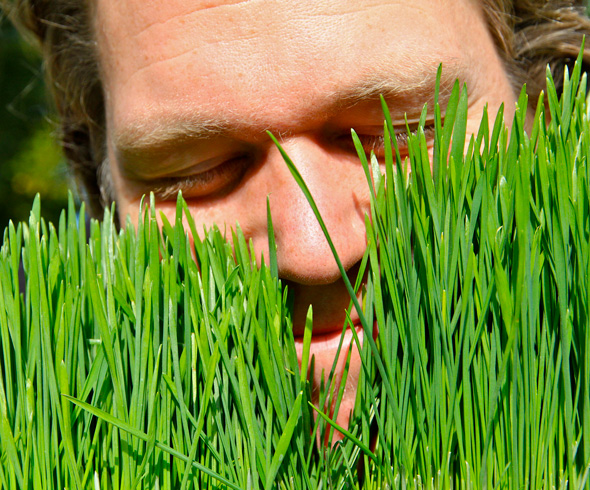
By Devon Chappell
Grass: it cushions bare feet, the games of children, and sometimes even lovers. We all recognize the external enjoyment we get from that lovely, green, growing carpet, but what can it do for you internally?
Ever wanted to roll around on that freshly cut lawn just to have that lovely scent surround your whole body, but without getting that itchy skin? Have you wondered why those patches of grass have started to sprout behind the glass of every juice and smoothie bar, as well as some health food stores and grocery counters? Ever just wondered what the heck is the big deal about wheatgrass? Well, if you answered, “yes,” to any of these questions, read on. Those alive and seemingly misplaced little patches of lawn are very edible, easy to absorb, and make one heck of a toxin-fighting juice!
In practically every one of our everyday activities we are exposed to pollution. These toxins affect the regular function of our body as a whole. Pollution is in the air, the water, the food we ingest… even with our best efforts, toxins are near impossible to avoid. Since we can’t really avoid them, it’s very important for health and vitality that we keep our bodies strong and our immune systems functioning with a grand flow of red blood cells. On the quest for healthy mind/body/spirit, wheatgrass may just be the philosopher’s stone.
According to Ann Wigmore in The Wheatgrass Book, wheatgrass holds a series of protein and amino acids, carbs, minerals, and vitamins including A, B-complex, C, and E. One of the more important active ingredients in wheatgrass would perhaps be its abundance of enzymes. These include: cytochrome oxidase (antioxidant required for proper cell respiration), lipase (a fat-splitting enzyme), protease (a protein digester), amylase (facilitates starch digestion), catalase (catalyzes the decomposition of hydrogen peroxide into water and oxygen in the blood and body tissues), peroxidase (similar action to catalase, on a cellular level), transhydrogenase (aids in keeping the muscle tissue of the heart toned), and this superfood’s superpower: superoxide dismutase or SOD, says Wigmore. SOD is a compound that is found in all living cells and acts as an anti-inflammatory, an anti-aging enzyme, a protector against impurities, and a fighter of the effects of radiation. It may also prevent cellular damage following heart attacks or exposure to irritants.
Like any active green plant in which photosynthesis plays a role, wheatgrass contains the blood-cleansing and blood-building attributes of chlorophyll. According to Wigmore, about 70 per cent of wheatgrass’ solid matter contains chlorophyll. Because wheatgrass helps to build red blood cells, it increases the supply of oxygen throughout your body. Better circulation means more efficient waste removal. This in turn helps detoxify your liver so that it is better able to filter all the toxins we were discussing earlier.
Imagine your life without the action of filtering! It would be like making an espresso and drinking the grounds, or trying to run your vehicle without an oil filter. The liver is vital to our health. So, in today’s highly polluted world, why not take extra care to strengthen one of the most useful organs of the body? Our bodies are a bit more complex than a vehicle; we can’t just run down to Canadian Tire and pick up a new filter on sale.
Cooking wheatgrass practically destroys all the nutrients. The best way to get wheatgrass into your diet is to get a juicer or a Vita-mix, or if you’re feeling brave, start adding it to salads. Like the plants that surround us, we are all capable of existing in a healthy, growing, alive world.
Recipes
Wheatgrass juice is a juice, so just add it to your healthy, natural juice or smoothie, or just take it as a shot; it tastes like a freshly-cut lawn. You can also toss some blades onto a salad or into a shake or smoothie, but because we are not cows, it’s easier to get the most out of it by juicing. And how does one get the wheatgrass to make into juice? Well, I’ll tell you:
Materials
- Organic wheat berries, “hard” or “winter” (find at health food store)
- Topsoil and peat moss
- 2 cookie sheets or cafeteria trays, approximately 10″ x 14″ in size
- Large glass canning jar plus a screen/cheesecloth for the top
- Pre-planting / Planting
Wash one cup of dry wheat berries—this is the amount to cover one cafeteria tray. Place in jar, fill with water, and let sit overnight or for 12 hours. Drain after soaking, and rinse well. Let the soaked wheat berries sit on a 45 degree angle for another 12 hours, to begin the sprouting process. Spread a one-inch-deep layer of soil onto a pan/sheet. Spread the sprouted wheat evenly onto the soil with hands. Dampen with water and cover with another tray for two – three days. Uncover on day four, water, and set in indirect sunlight continuing to water daily or every other day to keep moist.
Harvest
Boom, easy! Now start the journey towards more vital and glorious health. What’s even more fun than trying recipes is growing your own food. Watch those little lovelies grow for six to twelve days or until the grass is about 7 to 10 inches tall. Harvest by cutting with a sharp knife or scissors very close to the roots, use immediately, and enjoy life, my friends!
Devon Chappell is something of an impressionist with therapeutic hands. He holds a focus on what is real when it comes to food. He has a personal interest in nutrition and art and when he is in his element, Devon brings nature to the kitchen.

